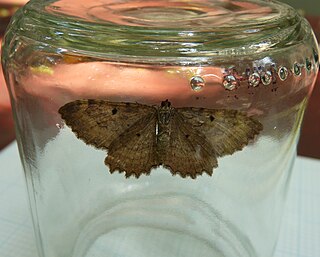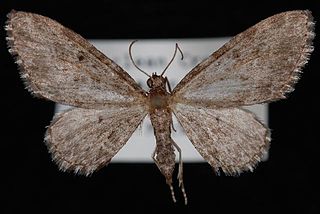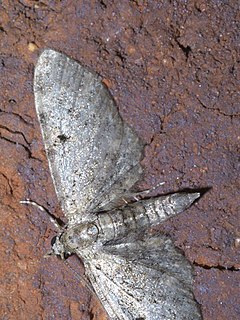Xanthophysa is a monotypic moth genus of the family Crambidae described by Eugene G. Munroe in 1964. It contains only one species, Xanthophysa psychialis, the xanthophysa moth, described by George Duryea Hulst in 1886. It is found in North America, where it has been recorded from Alabama, Florida, Illinois, Indiana, Kentucky, Maine, Mississippi, New Hampshire, New Jersey, North Carolina, Ohio, Ontario, Quebec, South Carolina and Tennessee.
Aethaloida is a monotypic moth genus in the family Geometridae erected by James Halliday McDunnough in 1920. Its only species, Aethaloida packardaria, was first described by George Duryea Hulst in 1888. It is found in the US state of California.

Coryphista is a monotypic moth genus in the family Geometridae erected by George Duryea Hulst in 1896. The genus may be considered to be a synonym of Rheumaptera. Its only species, Coryphista meadii, the barberry geometer moth or barberry looper, was first described by Alpheus Spring Packard in 1874. It is found in the United States and southern Canada.
Holochroa is a monotypic moth genus in the family Geometridae. Its only species, Holochroa dissociarius, is found in North America. The species was described by George Duryea Hulst in 1887 and he described the genus nine years later in 1896.
Lophosis is a monotypic geometrid moth genus. Its only species, Lophosis labeculata, the stained lophosis moth, is found in North America. Both the genus and species were first described by George Duryea Hulst, the genus in 1896 and the species in 1887.

Mesothea is a monotypic moth genus in the family Geometridae described by Warren in 1901. Its only species, Mesothea incertata, the day emerald or plain emerald, was first described by Walker in 1863. It is found in North America.
Monostoecha is a monotypic moth genus in the family Geometridae described by David Stephen Fletcher in 1979. Its only species, Monostoecha semipectinata, first described by George Duryea Hulst in 1898, is found in the American Southwest.

Monoptilota is a genus of snout moths. It was described by George Duryea Hulst in 1900. It contains only one species, the lima-bean vine borer moth, which is found in the central and south-eastern parts of the United States.
Catastia incorruscella is a species of snout moth in the genus Catastia. It was described by George Duryea Hulst in 1895. It is found in North America, including Colorado, Utah and California.
Cactobrosis is a genus of snout moths in the subfamily Phycitinae. It was erected by Harrison Gray Dyar Jr. in 1914. Some sources list it as a synonym of Zophodia, while others retain it as a valid genus.

Zophodia is a genus of snout moths in the subfamily Phycitinae. It was erected by Jacob Hübner in 1825.

Melitara is a genus of snout moths in the subfamily Phycitinae. It was described by Francis Walker in 1863. Some sources list it as a synonym of Zophodia, while others retain it as a valid genus.
Melitara junctolineella is a species of snout moth in the genus Melitara. It was described by George Duryea Hulst in 1900. It is found in southern Texas and Mexico. The species has been introduced in Australia as a biological control agent of Opuntia stricta.
Zophodia ebeniella is a species of snout moth in the genus Zophodia. It was described by Émile Louis Ragonot in 1888. It is found in Mozambique and South Africa.
Eupithecia insolabilis is a moth in the family Geometridae first described by George Duryea Hulst in 1900. It is found in the southern United States, including Utah, Arizona and New Mexico.
Eupithecia bolterii is a moth in the family Geometridae first described by George Duryea Hulst in 1900. It is found in the US states of Arizona and Texas.

Eupithecia lachrymosa is a moth in the family Geometridae first described by George Duryea Hulst in 1900. It is found in North America from central Saskatchewan west to southern Vancouver Island, north to British Columbia and Alberta and south to California.

Pero occidentalis, the western pero, is a species of geometrid moth in the family Geometridae. It was described by George Duryea Hulst in 1896 and is found in North America.
Neoterpes ephelidaria is a species of geometrid moth in the family Geometridae. It was described by George Duryea Hulst in 1886 and is found in North America.

Tornos is a genus of geometrid moths in the family Geometridae erected by Morrison in 1875. There are about 17 described species in Tornos.







